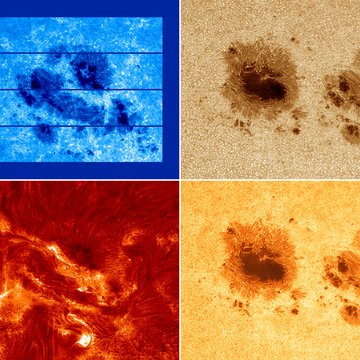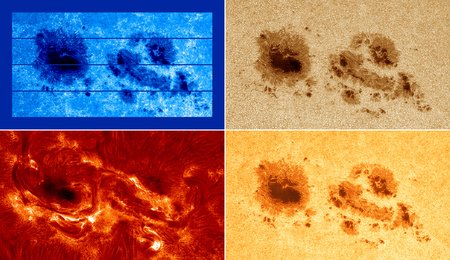Rare High-resolution Observations of a Flare-prolific Solar Active Region

Mosaics of GREGOR observations in different wavelength bands showing the active region NOAA 14274 at around 08:33 UT on 10 November 2025, about 30 minutes before an X1.2 flare began.
Credit: AIP / C. DenkerScientists have captured an exceptionally rare, high-resolution view of an active region that produced two powerful X-class solar flares—an achievement rarely possible from Earth. Using the GREGOR solar telescope in Tenerife, researchers recorded the explosive activity of the Sun’s most energetic sunspot group of 2025, revealing twisted magnetic structures and the early stages of flare ignition with unprecedented detail. The flares triggered fast coronal mass ejections that lit up Earth’s skies with vivid auroras in the nights that followed.
High-resolution observations of strong solar flares are extremely rare and difficult to obtain with ground-based solar telescopes. “Strong flares occur either on the backside of the Sun, or during the night, or when the weather is cloudy, or when the seeing conditions are poor, or when they are just outside the field of view, where the telescope is pointing”, says Prof. Carsten Denker head of the Solar Physics section at the Leibniz Institute for Astrophysics Potsdam (AIP) and first author of the newly published study. “We were extremely lucky to cover the evolution of two of the X-class flares on 10 and 11 November 2025 with the 1.5-meter GREGOR solar telescope at the Teide Observatory in Tenerife, Spain.”
Sunspots in the active region NOAA 14274 produced 135 C-class, 15 M-class, and 5 X-class flares. X-class solar flares are the most powerful type, representing the highest category in the system scientists use to classify flare strength. Flare classes differ by a factor of 10 in X-ray emission. These flares are part of Solar Cycle 25, the current 11-year cycle of solar activity that began in December 2019 and is expected to peak around 2025, marked by an increase in sunspots, solar flares, and auroras. Less than 100 X-class flares have been observed during Solar Cycle 25 thus far. This complex sunspot group was the most active region in 2025. The X5.1 flare on 11 November 2025, was the sixth strongest of the current solar cycle. The two X-class flares on 10 and 11 November 2025, were accompanied by fast coronal mass ejections, resulting in strong auroras on Earth in the following nights.
The observations were taken with four fast cameras of the improved High-resolution Fast Imager at the GREGOR solar telescope in Tenerife, which is designed, built, and operated by the Leibniz Institute of Astrophysics Potsdam (AIP). The telescope was pointed at 7 × 4 locations on the solar surface, creating a raster scan of the active region in 14 minutes with a size of about 175,000 km × 110,000 km. This observing mode was tested for the first time to capture a large, complex active region containing many individual sunspots. Image restoration was used to recover the fine structure of sunspots in all 28 tiles of the mosaic. Just 30 minutes after the raster scan, an X1.2 flare occurred in the active region, and the flare's precursors were already visible.
“The penumbral fibrils, which typically extend radially from the dark umbral core, were strongly curved and braided,” explains Dr. Meetu Verma, solar scientist at AIP and co-author of the study. This indicates a highly stressed magnetic field structure. Additionally, sunspot rotation and shear motions created an environment in which the energy stored in the magnetic field could be released explosively. Remarkably, the energy release started at penumbral filaments at spatial scales, which are close to the GREGOR solar telescope’s spatial resolving power of 100 km on the solar surface.
During the November 2025 observing campaign, nearly 40,000 datasets were recorded for image restoration and are currently being prepared for scientific analysis. The high-resolution images published in the journal “Research Note of the AAS” offer an initial look at the data quality and science that will be presented in future publications.

Mosaics of GREGOR observations in different wavelength bands showing the active region NOAA 14274 at around 08:33 UT on 10 November 2025, about 30 minutes before an X1.2 flare began.
Credit: AIP / C. DenkerScientists have captured an exceptionally rare, high-resolution view of an active region that produced two powerful X-class solar flares—an achievement rarely possible from Earth. Using the GREGOR solar telescope in Tenerife, researchers recorded the explosive activity of the Sun’s most energetic sunspot group of 2025, revealing twisted magnetic structures and the early stages of flare ignition with unprecedented detail. The flares triggered fast coronal mass ejections that lit up Earth’s skies with vivid auroras in the nights that followed.
High-resolution observations of strong solar flares are extremely rare and difficult to obtain with ground-based solar telescopes. “Strong flares occur either on the backside of the Sun, or during the night, or when the weather is cloudy, or when the seeing conditions are poor, or when they are just outside the field of view, where the telescope is pointing”, says Prof. Carsten Denker head of the Solar Physics section at the Leibniz Institute for Astrophysics Potsdam (AIP) and first author of the newly published study. “We were extremely lucky to cover the evolution of two of the X-class flares on 10 and 11 November 2025 with the 1.5-meter GREGOR solar telescope at the Teide Observatory in Tenerife, Spain.”
Sunspots in the active region NOAA 14274 produced 135 C-class, 15 M-class, and 5 X-class flares. X-class solar flares are the most powerful type, representing the highest category in the system scientists use to classify flare strength. Flare classes differ by a factor of 10 in X-ray emission. These flares are part of Solar Cycle 25, the current 11-year cycle of solar activity that began in December 2019 and is expected to peak around 2025, marked by an increase in sunspots, solar flares, and auroras. Less than 100 X-class flares have been observed during Solar Cycle 25 thus far. This complex sunspot group was the most active region in 2025. The X5.1 flare on 11 November 2025, was the sixth strongest of the current solar cycle. The two X-class flares on 10 and 11 November 2025, were accompanied by fast coronal mass ejections, resulting in strong auroras on Earth in the following nights.
The observations were taken with four fast cameras of the improved High-resolution Fast Imager at the GREGOR solar telescope in Tenerife, which is designed, built, and operated by the Leibniz Institute of Astrophysics Potsdam (AIP). The telescope was pointed at 7 × 4 locations on the solar surface, creating a raster scan of the active region in 14 minutes with a size of about 175,000 km × 110,000 km. This observing mode was tested for the first time to capture a large, complex active region containing many individual sunspots. Image restoration was used to recover the fine structure of sunspots in all 28 tiles of the mosaic. Just 30 minutes after the raster scan, an X1.2 flare occurred in the active region, and the flare's precursors were already visible.
“The penumbral fibrils, which typically extend radially from the dark umbral core, were strongly curved and braided,” explains Dr. Meetu Verma, solar scientist at AIP and co-author of the study. This indicates a highly stressed magnetic field structure. Additionally, sunspot rotation and shear motions created an environment in which the energy stored in the magnetic field could be released explosively. Remarkably, the energy release started at penumbral filaments at spatial scales, which are close to the GREGOR solar telescope’s spatial resolving power of 100 km on the solar surface.
During the November 2025 observing campaign, nearly 40,000 datasets were recorded for image restoration and are currently being prepared for scientific analysis. The high-resolution images published in the journal “Research Note of the AAS” offer an initial look at the data quality and science that will be presented in future publications.
Images
Mosaics of GREGOR observations in different wavelength bands showing the active region NOAA 14274 at around 08:33 UT on 10 November 2025, about 30 minutes before an X1.2 flare began.
Big screen size [1000 x 577, 180 KB]
Original size [10232 x 5912, 7.9 MB]



